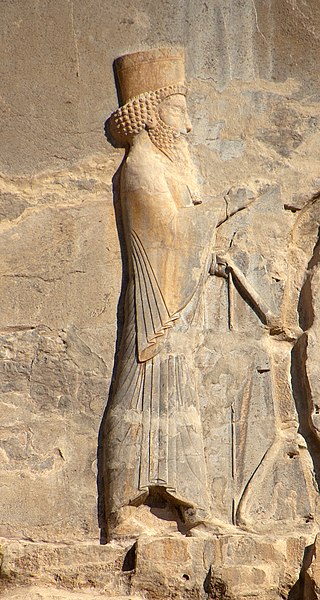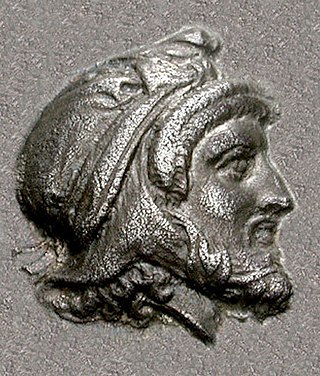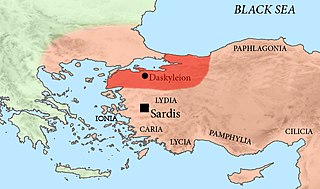
Arses, known by his regnal name Artaxerxes II, was King of Kings of the Achaemenid Empire from 405/4 BC to 358 BC. He was the son and successor of Darius II and his mother was Parysatis.
Artabazos was a Persian general in the army of Xerxes I, and later satrap of Hellespontine Phrygia under the Achaemenid dynasty, founder of the Pharnacid dynasty of satraps. He was the son of Pharnaces, who was the younger brother of Hystaspes, father of Darius I. Artabazos was therefore a first cousin of the great Achaemenid ruler Darius I.

Pharnabazus II was a Persian soldier and statesman, and Satrap of Hellespontine Phrygia. He was the son of Pharnaces II of Phrygia and grandson of Pharnabazus I, and great-grandson of Artabazus I. He and his male ancestors, forming the Pharnacid dynasty, had governed the satrapy of Hellespontine Phrygia from its headquarters at Dascylium since 478 BC. He married Apama, daughter of Artaxerxes II of Persia, and their son Artabazus also became a satrap of Phrygia. According to some accounts, his granddaughter Barsine may have become Alexander the Great's concubine.

Ochus, known by his dynastic name Artaxerxes III, was King of Kings of the Achaemenid Empire from 359/58 to 338 BC. He was the son and successor of Artaxerxes II and his mother was Stateira.

Ariobarzanes, sometimes known as Ariobarzanes I of Cius, was a Persian Satrap of Phrygia and military commander, leader of an independence revolt, and the first known of the line of rulers of the Greek town of Cius from which were eventually to stem the kings of Pontus in the 3rd century BCE. Ariobarzanes was apparently a cadet member of the Achaemenid dynasty, possibly son of Pharnabazus II, and part of the Pharnacid dynasty which had settled to hold Dascylium of Hellespont in the 470s BCE. Cius is located near Dascylium, and Cius seemingly was a share of family holdings for the branch of Ariobarzanes.

Autophradates was a Persian Satrap of Lydia, who also distinguished himself as a general in the reign of Artaxerxes III and Darius III.

Artabazos II was a Persian general and satrap of Hellespontine Phrygia. He was the son of the Persian satrap of Hellespontine Phrygia Pharnabazus II, and younger kinsman of Ariobarzanes of Phrygia who revolted against Artaxerxes II around 356 BC. His first wife was an unnamed Greek woman from Rhodes, sister of the two mercenaries Mentor of Rhodes and Memnon of Rhodes. Towards the end of his life, he became satrap of Bactria for Alexander the Great.
Artakama was a Persian noblewoman and the second wife of Ptolemy I Soter, a Macedonian general under Alexander the Great and the first Pharaoh of the Ptolemaic dynasty of Egypt.
Pharnabazus or Pharnabazos is the Hellenized form of an ancient Persian name. It may refer to:
Pharnabazus III was a Persian satrap who fought against Alexander the Great. His father was Artabazus II, and his mother a Greek from Rhodes.

Dascylium, Dascyleium, or Daskyleion, also known as Dascylus, was a town in Anatolia some 30 kilometres (19 mi) inland from the coast of the Propontis, at modern Ergili, Turkey. Its site was rediscovered in 1952 and has since been excavated.

Pharnaces II ruled the satrapy of Hellespontine Phrygia under the Achaemenid Dynasty of Persia. Hellespontine Phrygia comprised the lands of Troad, Mysia and Bithynia and had its seat at Daskyleion, south of Cyzicus, Mysia.

Pharnabazus, was a member of the Pharnacid dynasty that governed the province of Hellespontine Phrygia as satraps for the Achaemenid Empire.

Hellespontine Phrygia or Lesser Phrygia was a Persian satrapy (province) in northwestern Anatolia, directly southeast of the Hellespont. Its capital was Dascylium, and for most of its existence it was ruled by the hereditary Persian Pharnacid dynasty. Together with Greater Phrygia, it made up the administrative provinces of the wider Phrygia region.

Pharnaces Ι was a son of Arsames. He was a younger brother of Hystaspes, and therefore an uncle of Achaemenid Emperor Darius I, son of Hystaspes. He was the founder of the Pharnacid dynasty that ruled over Hellespontine Phrygia.

Mitrobates ; was an Achaemenid satrap of Daskyleion under the reigns of Cyrus the Great, who nominated him for the role, and Cambyses. After Cambyses died, and during the struggles for succession that followed, he is said to have been assassinated, together with his son Cranaspes, by the neighbouring satrap of Lydia, Oroetes, who wanted to expand his Anatolian territories. After the assassination, Oroetes added the territory of Hellespontine Phrygia to his own.
After Cambyses had died and the Magians won the kingship, Oroetes stayed in Sardis, where he in no way helped the Persians to regain the power taken from them by the Medes, but contrariwise; for in this confusion he slew two notable Persians, Mitrobates, the governor from Dascyleium, who had taunted him concerning Polycrates, and Mitrobates' son Cranaspes; and besides many other violent deeds, when a messenger from Darius came with a message which displeased him, he set an ambush by the way and killed that messenger on his journey homewards, and made away with the man's body and horse. So when Darius became king he was minded to punish Oroetes for all his wrongdoing, and chiefly for the killing of Mitrobates and his son.

Artyphius was a general of the Achaemenid Army during the Second Persian invasion of Greece. He was the son of Artabanus, grandson of Hystaspes, and therefore nephew of Darius the Great and first degree cousin of Xerxes I.

Gandāra, or Gadāra in Achaemenid inscriptions was one of the easternmost provinces of the Achaemenid Empire in South Asia, following the Achaemenid invasion of the Indus Valley. It appears in various Achaemenid inscriptions such as the Behistun Inscription, or the DNa inscription of Darius the Great.

Oebares II was, according to Herodotus a son of Megabazus, himself a first degree cousin of Darius I. Oebares became satrap of Daskyleion in 493 BC, after his father.













